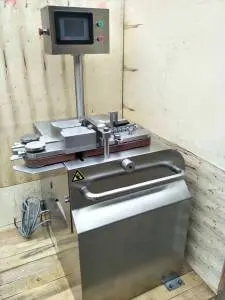
Dec . 04, 2024 16:23 Back to list
Sausage Knotting Equipment Price List and Specifications Guide
Understanding the Sausage Knotter Pricelist A Comprehensive Guide
In the world of sausage production, efficiency and precision are paramount. One critical tool that enhances these qualities is the sausage knotter. This machine automates the process of tying off sausage casings, ensuring that each link is sealed properly and consistently. As the demand for quality sausages rises, understanding the pricing structure of sausage knotters becomes essential for producers looking to optimize their operations. This article delves into the various factors that influence the pricing of sausage knotters, presents an overview of common price ranges, and offers tips for selecting the right equipment for your needs.
Factors Influencing Prices
1. Type of Knotter There are various types of sausage knotters on the market, including manual, semi-automatic, and fully automatic models. Manual knotters are typically the most affordable, ranging from $100 to $500, while fully automatic models can cost several thousand dollars, depending on their capacity and features. The choice between manual and automatic will depend on your production volume and budget.
2. Brand and Quality Well-known brands with a reputation for durability and efficient performance often come with a higher price tag. Investing in a reputable brand may save costs in the long run due to lower maintenance needs and increased reliability.
3. Features and Functionality Advanced features such as digital displays, programmable settings, and enhanced safety measures can significantly increase the price of a sausage knotter. When assessing the pricelist, producers should consider how these features align with their production needs. For example, larger operations may benefit from programmable models that can handle higher volume and various casing sizes.
4. Material and Build The construction material of a sausage knotter can also play a role in its price. Machines made from stainless steel, for instance, are more resistant to corrosion and easier to clean, which justifies a higher cost compared to those made from less durable materials.
5. After-Sales Support Pricing can also be influenced by the level of after-sales support provided by the manufacturer. Machines that come with comprehensive warranties, maintenance services, and customer support may carry a higher initial price but can lead to reduced operational costs over time.
Average Price Ranges
sausage knotter pricelist

Understanding the typical cost ranges can help sausage producers set realistic budgets. Here’s a breakdown based on different types of knotters
- Manual Sausage Knotters $100 - $500 - Semi-Automatic Sausage Knotters $500 - $2,000 - Fully Automatic Sausage Knotters $2,000 - $10,000 (or more, depending on specific capabilities)
These prices may fluctuate based on regional market differences, demand, and availability, so it's advisable to shop around and compare offerings from different suppliers.
Tips for Selecting the Right Knotter
1. Assess Your Production Needs Determine your daily sausage output and the types of casings you use. This will guide you in choosing the appropriate knotter that matches your operational capacity.
2. Consider Future Growth If you plan to expand your production, investing in a knotter with a higher capacity might be wise, even if it requires a larger upfront investment.
3. Evaluate Total Cost of Ownership Don’t just consider the purchase price. Factor in maintenance, operational costs, and potential downtimes to get a true picture of the investment.
4. Seek Recommendations Connecting with other sausage producers can provide insights into the performance of various brands and models, helping you make an informed decision.
In conclusion, understanding the sausage knotter pricelist is crucial for optimizing efficiency in sausage production. By considering the various factors influencing prices, evaluating your production needs, and comparing different models, you can make a smarter purchasing decision that enhances productivity and quality in your sausage operations.